Evaluation of Organisational Design and HR Development at Tesco PLC
VerifiedAdded on 2023/01/18
|14
|4402
|67
Report
AI Summary
This report provides an in-depth analysis of organisational design and human resource management, using Tesco PLC as a case study. It begins by evaluating the importance of organisational design theory, emphasizing its role in enhancing efficiency, decision-making, and productivity within the company. The report then delves into various techniques and approaches for developing human resources, including an examination of motivation theories such as Maslow's hierarchy of needs and Vroom's expectancy theory, along with human capital and knowledge management strategies. Contemporary knowledge is applied through research to support emerging Human Resource developments, covering recruitment, orientation, working conditions, and employee relations. Finally, the report explores the relationship between organisational design and change management, highlighting how Tesco PLC can adapt and respond to changes in its environment. The report concludes by summarizing the key findings and their implications for Tesco PLC's success.
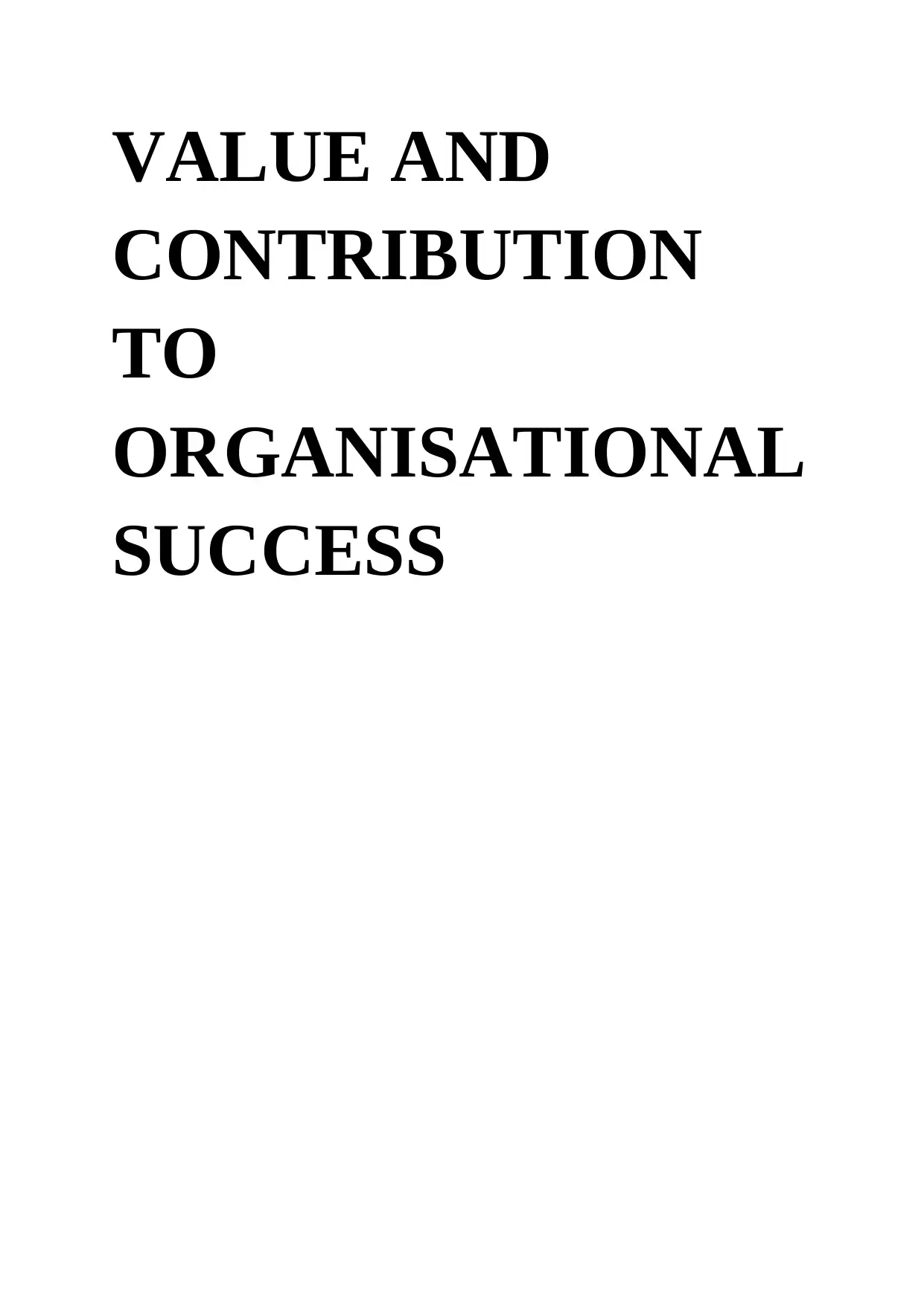
VALUE AND
CONTRIBUTION
TO
ORGANISATIONAL
SUCCESS
CONTRIBUTION
TO
ORGANISATIONAL
SUCCESS
Paraphrase This Document
Need a fresh take? Get an instant paraphrase of this document with our AI Paraphraser
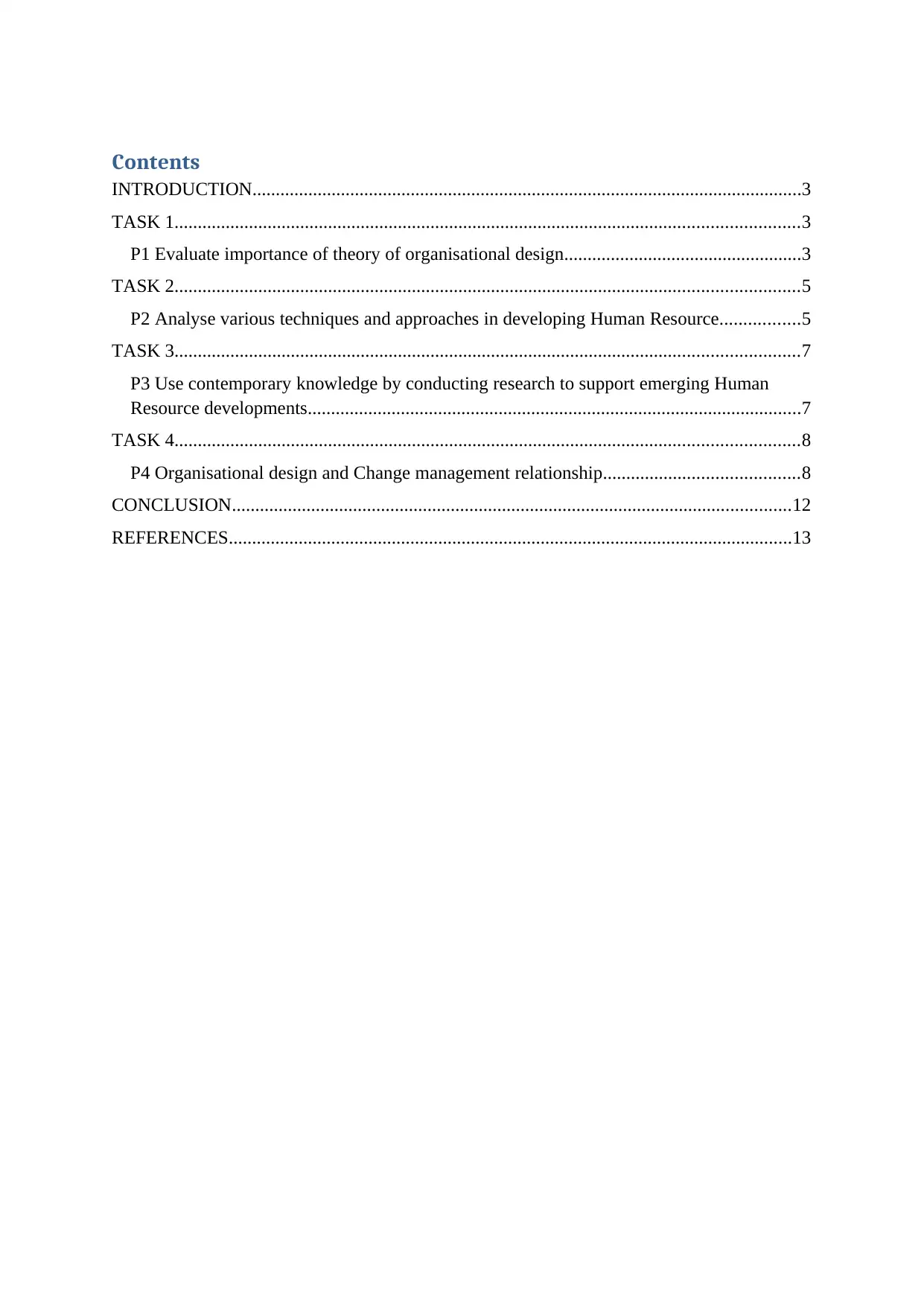
Contents
INTRODUCTION......................................................................................................................3
TASK 1......................................................................................................................................3
P1 Evaluate importance of theory of organisational design...................................................3
TASK 2......................................................................................................................................5
P2 Analyse various techniques and approaches in developing Human Resource.................5
TASK 3......................................................................................................................................7
P3 Use contemporary knowledge by conducting research to support emerging Human
Resource developments..........................................................................................................7
TASK 4......................................................................................................................................8
P4 Organisational design and Change management relationship..........................................8
CONCLUSION........................................................................................................................12
REFERENCES.........................................................................................................................13
INTRODUCTION......................................................................................................................3
TASK 1......................................................................................................................................3
P1 Evaluate importance of theory of organisational design...................................................3
TASK 2......................................................................................................................................5
P2 Analyse various techniques and approaches in developing Human Resource.................5
TASK 3......................................................................................................................................7
P3 Use contemporary knowledge by conducting research to support emerging Human
Resource developments..........................................................................................................7
TASK 4......................................................................................................................................8
P4 Organisational design and Change management relationship..........................................8
CONCLUSION........................................................................................................................12
REFERENCES.........................................................................................................................13
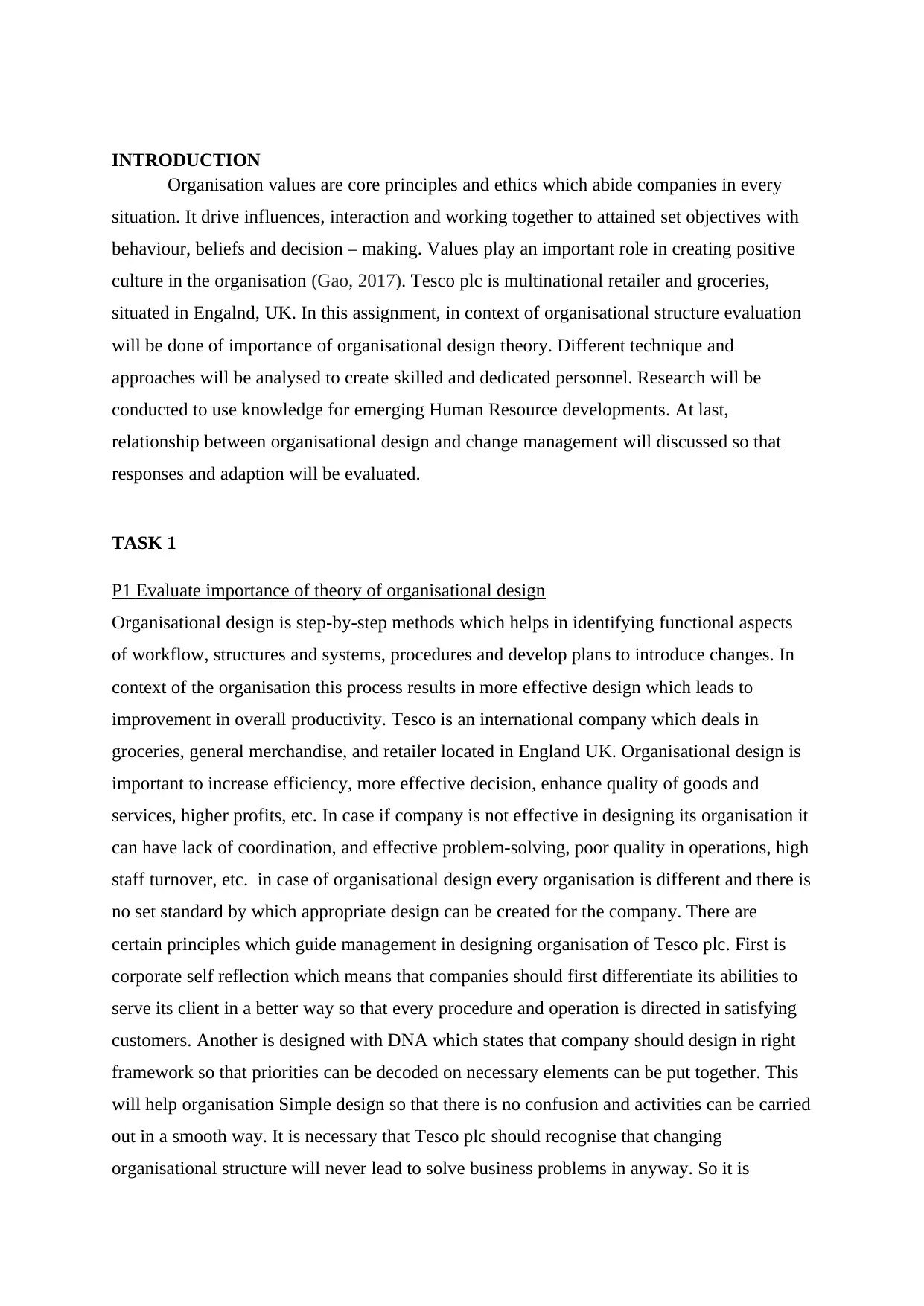
INTRODUCTION
Organisation values are core principles and ethics which abide companies in every
situation. It drive influences, interaction and working together to attained set objectives with
behaviour, beliefs and decision – making. Values play an important role in creating positive
culture in the organisation (Gao, 2017). Tesco plc is multinational retailer and groceries,
situated in Engalnd, UK. In this assignment, in context of organisational structure evaluation
will be done of importance of organisational design theory. Different technique and
approaches will be analysed to create skilled and dedicated personnel. Research will be
conducted to use knowledge for emerging Human Resource developments. At last,
relationship between organisational design and change management will discussed so that
responses and adaption will be evaluated.
TASK 1
P1 Evaluate importance of theory of organisational design
Organisational design is step-by-step methods which helps in identifying functional aspects
of workflow, structures and systems, procedures and develop plans to introduce changes. In
context of the organisation this process results in more effective design which leads to
improvement in overall productivity. Tesco is an international company which deals in
groceries, general merchandise, and retailer located in England UK. Organisational design is
important to increase efficiency, more effective decision, enhance quality of goods and
services, higher profits, etc. In case if company is not effective in designing its organisation it
can have lack of coordination, and effective problem-solving, poor quality in operations, high
staff turnover, etc. in case of organisational design every organisation is different and there is
no set standard by which appropriate design can be created for the company. There are
certain principles which guide management in designing organisation of Tesco plc. First is
corporate self reflection which means that companies should first differentiate its abilities to
serve its client in a better way so that every procedure and operation is directed in satisfying
customers. Another is designed with DNA which states that company should design in right
framework so that priorities can be decoded on necessary elements can be put together. This
will help organisation Simple design so that there is no confusion and activities can be carried
out in a smooth way. It is necessary that Tesco plc should recognise that changing
organisational structure will never lead to solve business problems in anyway. So it is
Organisation values are core principles and ethics which abide companies in every
situation. It drive influences, interaction and working together to attained set objectives with
behaviour, beliefs and decision – making. Values play an important role in creating positive
culture in the organisation (Gao, 2017). Tesco plc is multinational retailer and groceries,
situated in Engalnd, UK. In this assignment, in context of organisational structure evaluation
will be done of importance of organisational design theory. Different technique and
approaches will be analysed to create skilled and dedicated personnel. Research will be
conducted to use knowledge for emerging Human Resource developments. At last,
relationship between organisational design and change management will discussed so that
responses and adaption will be evaluated.
TASK 1
P1 Evaluate importance of theory of organisational design
Organisational design is step-by-step methods which helps in identifying functional aspects
of workflow, structures and systems, procedures and develop plans to introduce changes. In
context of the organisation this process results in more effective design which leads to
improvement in overall productivity. Tesco is an international company which deals in
groceries, general merchandise, and retailer located in England UK. Organisational design is
important to increase efficiency, more effective decision, enhance quality of goods and
services, higher profits, etc. In case if company is not effective in designing its organisation it
can have lack of coordination, and effective problem-solving, poor quality in operations, high
staff turnover, etc. in case of organisational design every organisation is different and there is
no set standard by which appropriate design can be created for the company. There are
certain principles which guide management in designing organisation of Tesco plc. First is
corporate self reflection which means that companies should first differentiate its abilities to
serve its client in a better way so that every procedure and operation is directed in satisfying
customers. Another is designed with DNA which states that company should design in right
framework so that priorities can be decoded on necessary elements can be put together. This
will help organisation Simple design so that there is no confusion and activities can be carried
out in a smooth way. It is necessary that Tesco plc should recognise that changing
organisational structure will never lead to solve business problems in anyway. So it is
⊘ This is a preview!⊘
Do you want full access?
Subscribe today to unlock all pages.

Trusted by 1+ million students worldwide
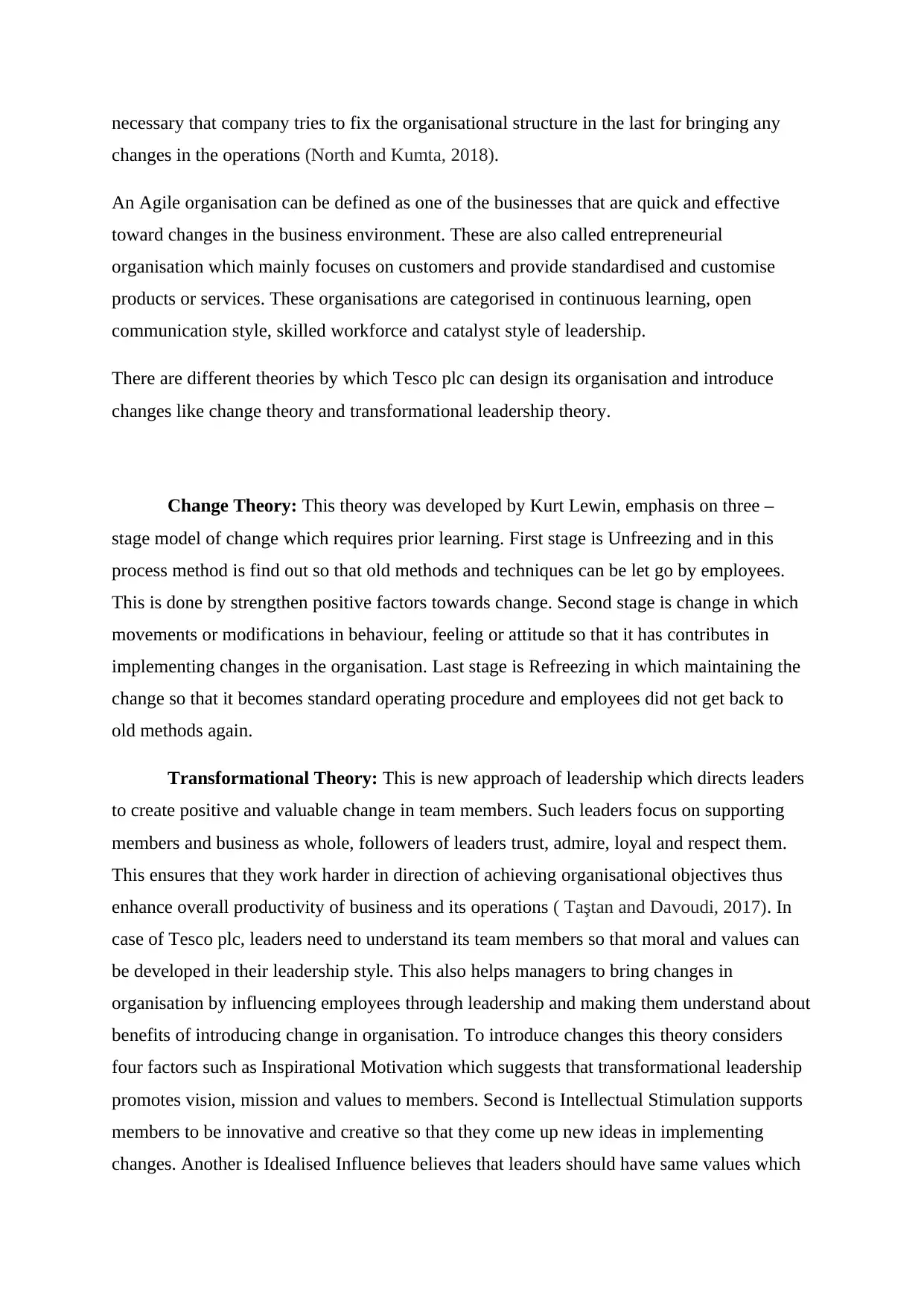
necessary that company tries to fix the organisational structure in the last for bringing any
changes in the operations (North and Kumta, 2018).
An Agile organisation can be defined as one of the businesses that are quick and effective
toward changes in the business environment. These are also called entrepreneurial
organisation which mainly focuses on customers and provide standardised and customise
products or services. These organisations are categorised in continuous learning, open
communication style, skilled workforce and catalyst style of leadership.
There are different theories by which Tesco plc can design its organisation and introduce
changes like change theory and transformational leadership theory.
Change Theory: This theory was developed by Kurt Lewin, emphasis on three –
stage model of change which requires prior learning. First stage is Unfreezing and in this
process method is find out so that old methods and techniques can be let go by employees.
This is done by strengthen positive factors towards change. Second stage is change in which
movements or modifications in behaviour, feeling or attitude so that it has contributes in
implementing changes in the organisation. Last stage is Refreezing in which maintaining the
change so that it becomes standard operating procedure and employees did not get back to
old methods again.
Transformational Theory: This is new approach of leadership which directs leaders
to create positive and valuable change in team members. Such leaders focus on supporting
members and business as whole, followers of leaders trust, admire, loyal and respect them.
This ensures that they work harder in direction of achieving organisational objectives thus
enhance overall productivity of business and its operations ( Taştan and Davoudi, 2017). In
case of Tesco plc, leaders need to understand its team members so that moral and values can
be developed in their leadership style. This also helps managers to bring changes in
organisation by influencing employees through leadership and making them understand about
benefits of introducing change in organisation. To introduce changes this theory considers
four factors such as Inspirational Motivation which suggests that transformational leadership
promotes vision, mission and values to members. Second is Intellectual Stimulation supports
members to be innovative and creative so that they come up new ideas in implementing
changes. Another is Idealised Influence believes that leaders should have same values which
changes in the operations (North and Kumta, 2018).
An Agile organisation can be defined as one of the businesses that are quick and effective
toward changes in the business environment. These are also called entrepreneurial
organisation which mainly focuses on customers and provide standardised and customise
products or services. These organisations are categorised in continuous learning, open
communication style, skilled workforce and catalyst style of leadership.
There are different theories by which Tesco plc can design its organisation and introduce
changes like change theory and transformational leadership theory.
Change Theory: This theory was developed by Kurt Lewin, emphasis on three –
stage model of change which requires prior learning. First stage is Unfreezing and in this
process method is find out so that old methods and techniques can be let go by employees.
This is done by strengthen positive factors towards change. Second stage is change in which
movements or modifications in behaviour, feeling or attitude so that it has contributes in
implementing changes in the organisation. Last stage is Refreezing in which maintaining the
change so that it becomes standard operating procedure and employees did not get back to
old methods again.
Transformational Theory: This is new approach of leadership which directs leaders
to create positive and valuable change in team members. Such leaders focus on supporting
members and business as whole, followers of leaders trust, admire, loyal and respect them.
This ensures that they work harder in direction of achieving organisational objectives thus
enhance overall productivity of business and its operations ( Taştan and Davoudi, 2017). In
case of Tesco plc, leaders need to understand its team members so that moral and values can
be developed in their leadership style. This also helps managers to bring changes in
organisation by influencing employees through leadership and making them understand about
benefits of introducing change in organisation. To introduce changes this theory considers
four factors such as Inspirational Motivation which suggests that transformational leadership
promotes vision, mission and values to members. Second is Intellectual Stimulation supports
members to be innovative and creative so that they come up new ideas in implementing
changes. Another is Idealised Influence believes that leaders should have same values which
Paraphrase This Document
Need a fresh take? Get an instant paraphrase of this document with our AI Paraphraser
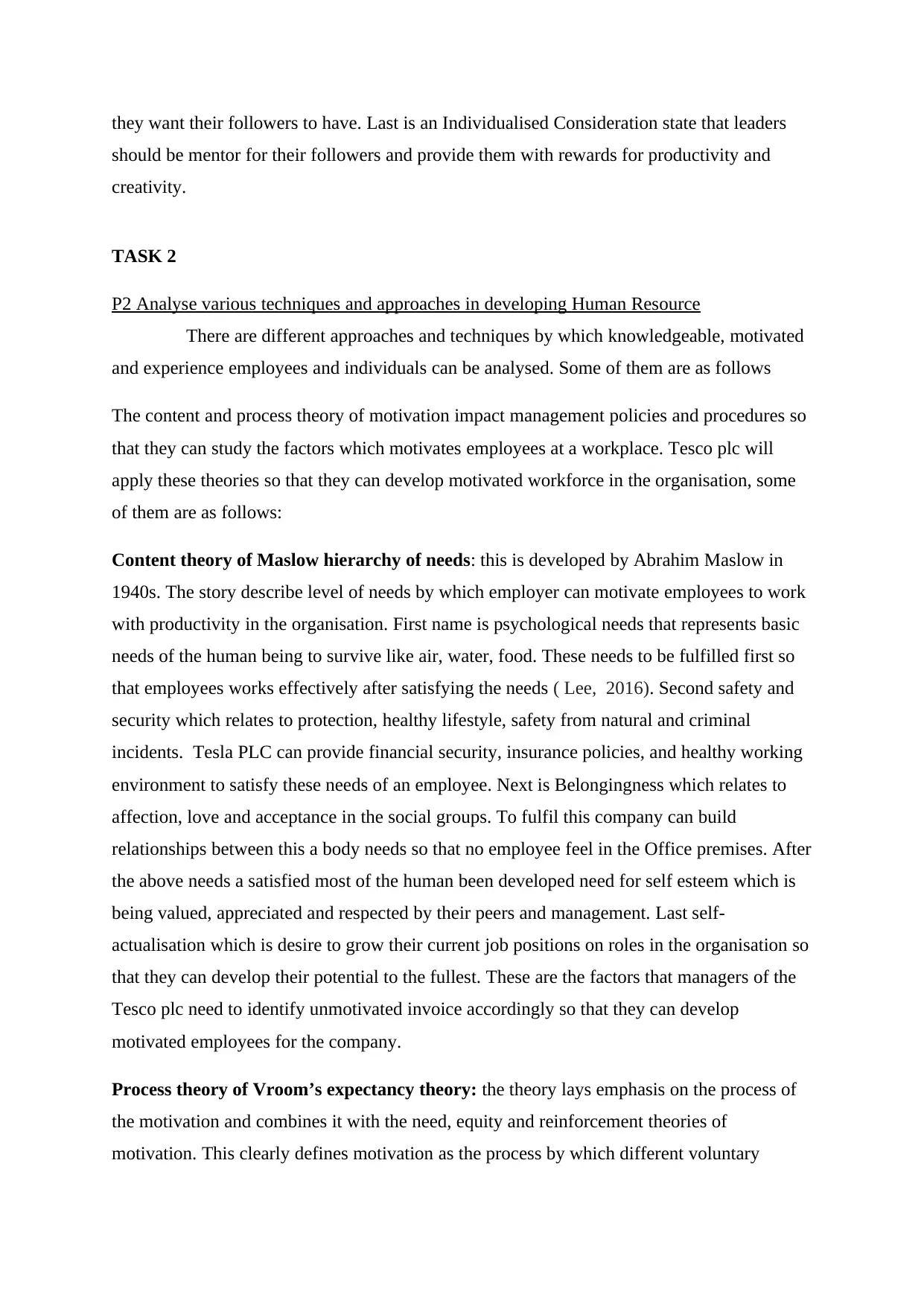
they want their followers to have. Last is an Individualised Consideration state that leaders
should be mentor for their followers and provide them with rewards for productivity and
creativity.
TASK 2
P2 Analyse various techniques and approaches in developing Human Resource
There are different approaches and techniques by which knowledgeable, motivated
and experience employees and individuals can be analysed. Some of them are as follows
The content and process theory of motivation impact management policies and procedures so
that they can study the factors which motivates employees at a workplace. Tesco plc will
apply these theories so that they can develop motivated workforce in the organisation, some
of them are as follows:
Content theory of Maslow hierarchy of needs: this is developed by Abrahim Maslow in
1940s. The story describe level of needs by which employer can motivate employees to work
with productivity in the organisation. First name is psychological needs that represents basic
needs of the human being to survive like air, water, food. These needs to be fulfilled first so
that employees works effectively after satisfying the needs ( Lee, 2016). Second safety and
security which relates to protection, healthy lifestyle, safety from natural and criminal
incidents. Tesla PLC can provide financial security, insurance policies, and healthy working
environment to satisfy these needs of an employee. Next is Belongingness which relates to
affection, love and acceptance in the social groups. To fulfil this company can build
relationships between this a body needs so that no employee feel in the Office premises. After
the above needs a satisfied most of the human been developed need for self esteem which is
being valued, appreciated and respected by their peers and management. Last self-
actualisation which is desire to grow their current job positions on roles in the organisation so
that they can develop their potential to the fullest. These are the factors that managers of the
Tesco plc need to identify unmotivated invoice accordingly so that they can develop
motivated employees for the company.
Process theory of Vroom’s expectancy theory: the theory lays emphasis on the process of
the motivation and combines it with the need, equity and reinforcement theories of
motivation. This clearly defines motivation as the process by which different voluntary
should be mentor for their followers and provide them with rewards for productivity and
creativity.
TASK 2
P2 Analyse various techniques and approaches in developing Human Resource
There are different approaches and techniques by which knowledgeable, motivated
and experience employees and individuals can be analysed. Some of them are as follows
The content and process theory of motivation impact management policies and procedures so
that they can study the factors which motivates employees at a workplace. Tesco plc will
apply these theories so that they can develop motivated workforce in the organisation, some
of them are as follows:
Content theory of Maslow hierarchy of needs: this is developed by Abrahim Maslow in
1940s. The story describe level of needs by which employer can motivate employees to work
with productivity in the organisation. First name is psychological needs that represents basic
needs of the human being to survive like air, water, food. These needs to be fulfilled first so
that employees works effectively after satisfying the needs ( Lee, 2016). Second safety and
security which relates to protection, healthy lifestyle, safety from natural and criminal
incidents. Tesla PLC can provide financial security, insurance policies, and healthy working
environment to satisfy these needs of an employee. Next is Belongingness which relates to
affection, love and acceptance in the social groups. To fulfil this company can build
relationships between this a body needs so that no employee feel in the Office premises. After
the above needs a satisfied most of the human been developed need for self esteem which is
being valued, appreciated and respected by their peers and management. Last self-
actualisation which is desire to grow their current job positions on roles in the organisation so
that they can develop their potential to the fullest. These are the factors that managers of the
Tesco plc need to identify unmotivated invoice accordingly so that they can develop
motivated employees for the company.
Process theory of Vroom’s expectancy theory: the theory lays emphasis on the process of
the motivation and combines it with the need, equity and reinforcement theories of
motivation. This clearly defines motivation as the process by which different voluntary
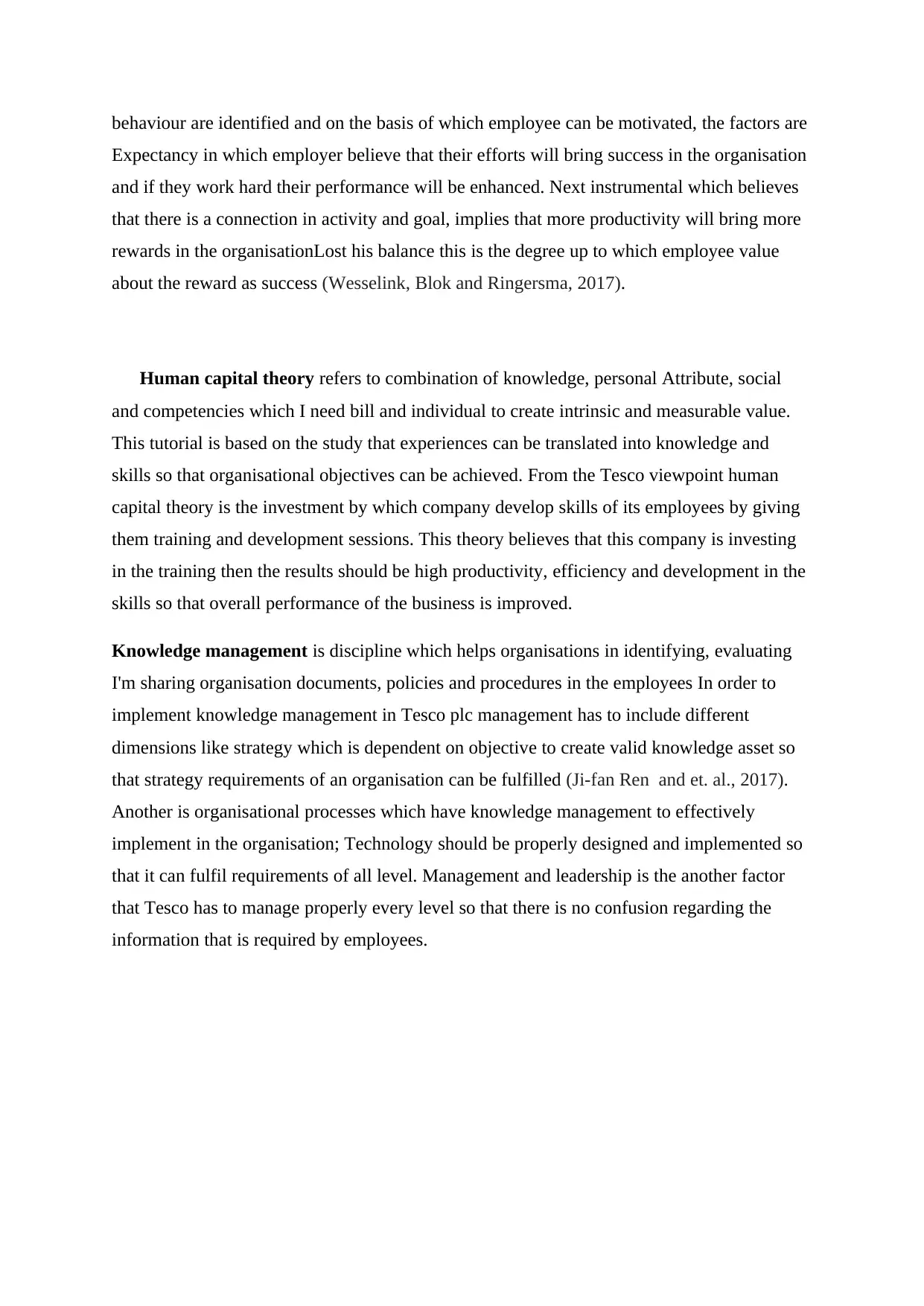
behaviour are identified and on the basis of which employee can be motivated, the factors are
Expectancy in which employer believe that their efforts will bring success in the organisation
and if they work hard their performance will be enhanced. Next instrumental which believes
that there is a connection in activity and goal, implies that more productivity will bring more
rewards in the organisationLost his balance this is the degree up to which employee value
about the reward as success (Wesselink, Blok and Ringersma, 2017).
Human capital theory refers to combination of knowledge, personal Attribute, social
and competencies which I need bill and individual to create intrinsic and measurable value.
This tutorial is based on the study that experiences can be translated into knowledge and
skills so that organisational objectives can be achieved. From the Tesco viewpoint human
capital theory is the investment by which company develop skills of its employees by giving
them training and development sessions. This theory believes that this company is investing
in the training then the results should be high productivity, efficiency and development in the
skills so that overall performance of the business is improved.
Knowledge management is discipline which helps organisations in identifying, evaluating
I'm sharing organisation documents, policies and procedures in the employees In order to
implement knowledge management in Tesco plc management has to include different
dimensions like strategy which is dependent on objective to create valid knowledge asset so
that strategy requirements of an organisation can be fulfilled (Ji-fan Ren and et. al., 2017).
Another is organisational processes which have knowledge management to effectively
implement in the organisation; Technology should be properly designed and implemented so
that it can fulfil requirements of all level. Management and leadership is the another factor
that Tesco has to manage properly every level so that there is no confusion regarding the
information that is required by employees.
Expectancy in which employer believe that their efforts will bring success in the organisation
and if they work hard their performance will be enhanced. Next instrumental which believes
that there is a connection in activity and goal, implies that more productivity will bring more
rewards in the organisationLost his balance this is the degree up to which employee value
about the reward as success (Wesselink, Blok and Ringersma, 2017).
Human capital theory refers to combination of knowledge, personal Attribute, social
and competencies which I need bill and individual to create intrinsic and measurable value.
This tutorial is based on the study that experiences can be translated into knowledge and
skills so that organisational objectives can be achieved. From the Tesco viewpoint human
capital theory is the investment by which company develop skills of its employees by giving
them training and development sessions. This theory believes that this company is investing
in the training then the results should be high productivity, efficiency and development in the
skills so that overall performance of the business is improved.
Knowledge management is discipline which helps organisations in identifying, evaluating
I'm sharing organisation documents, policies and procedures in the employees In order to
implement knowledge management in Tesco plc management has to include different
dimensions like strategy which is dependent on objective to create valid knowledge asset so
that strategy requirements of an organisation can be fulfilled (Ji-fan Ren and et. al., 2017).
Another is organisational processes which have knowledge management to effectively
implement in the organisation; Technology should be properly designed and implemented so
that it can fulfil requirements of all level. Management and leadership is the another factor
that Tesco has to manage properly every level so that there is no confusion regarding the
information that is required by employees.
⊘ This is a preview!⊘
Do you want full access?
Subscribe today to unlock all pages.

Trusted by 1+ million students worldwide
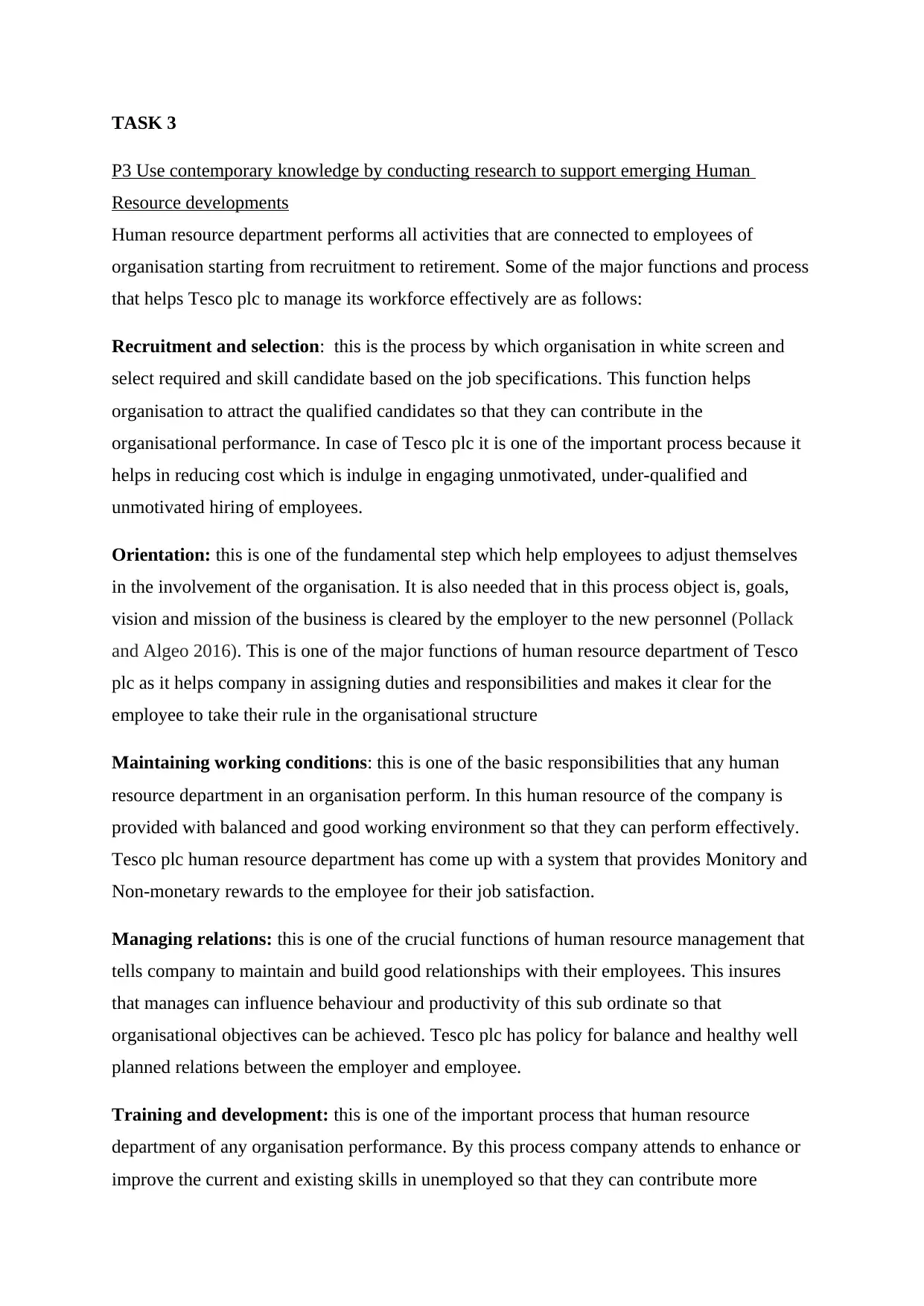
TASK 3
P3 Use contemporary knowledge by conducting research to support emerging Human
Resource developments
Human resource department performs all activities that are connected to employees of
organisation starting from recruitment to retirement. Some of the major functions and process
that helps Tesco plc to manage its workforce effectively are as follows:
Recruitment and selection: this is the process by which organisation in white screen and
select required and skill candidate based on the job specifications. This function helps
organisation to attract the qualified candidates so that they can contribute in the
organisational performance. In case of Tesco plc it is one of the important process because it
helps in reducing cost which is indulge in engaging unmotivated, under-qualified and
unmotivated hiring of employees.
Orientation: this is one of the fundamental step which help employees to adjust themselves
in the involvement of the organisation. It is also needed that in this process object is, goals,
vision and mission of the business is cleared by the employer to the new personnel (Pollack
and Algeo 2016). This is one of the major functions of human resource department of Tesco
plc as it helps company in assigning duties and responsibilities and makes it clear for the
employee to take their rule in the organisational structure
Maintaining working conditions: this is one of the basic responsibilities that any human
resource department in an organisation perform. In this human resource of the company is
provided with balanced and good working environment so that they can perform effectively.
Tesco plc human resource department has come up with a system that provides Monitory and
Non-monetary rewards to the employee for their job satisfaction.
Managing relations: this is one of the crucial functions of human resource management that
tells company to maintain and build good relationships with their employees. This insures
that manages can influence behaviour and productivity of this sub ordinate so that
organisational objectives can be achieved. Tesco plc has policy for balance and healthy well
planned relations between the employer and employee.
Training and development: this is one of the important process that human resource
department of any organisation performance. By this process company attends to enhance or
improve the current and existing skills in unemployed so that they can contribute more
P3 Use contemporary knowledge by conducting research to support emerging Human
Resource developments
Human resource department performs all activities that are connected to employees of
organisation starting from recruitment to retirement. Some of the major functions and process
that helps Tesco plc to manage its workforce effectively are as follows:
Recruitment and selection: this is the process by which organisation in white screen and
select required and skill candidate based on the job specifications. This function helps
organisation to attract the qualified candidates so that they can contribute in the
organisational performance. In case of Tesco plc it is one of the important process because it
helps in reducing cost which is indulge in engaging unmotivated, under-qualified and
unmotivated hiring of employees.
Orientation: this is one of the fundamental step which help employees to adjust themselves
in the involvement of the organisation. It is also needed that in this process object is, goals,
vision and mission of the business is cleared by the employer to the new personnel (Pollack
and Algeo 2016). This is one of the major functions of human resource department of Tesco
plc as it helps company in assigning duties and responsibilities and makes it clear for the
employee to take their rule in the organisational structure
Maintaining working conditions: this is one of the basic responsibilities that any human
resource department in an organisation perform. In this human resource of the company is
provided with balanced and good working environment so that they can perform effectively.
Tesco plc human resource department has come up with a system that provides Monitory and
Non-monetary rewards to the employee for their job satisfaction.
Managing relations: this is one of the crucial functions of human resource management that
tells company to maintain and build good relationships with their employees. This insures
that manages can influence behaviour and productivity of this sub ordinate so that
organisational objectives can be achieved. Tesco plc has policy for balance and healthy well
planned relations between the employer and employee.
Training and development: this is one of the important process that human resource
department of any organisation performance. By this process company attends to enhance or
improve the current and existing skills in unemployed so that they can contribute more
Paraphrase This Document
Need a fresh take? Get an instant paraphrase of this document with our AI Paraphraser
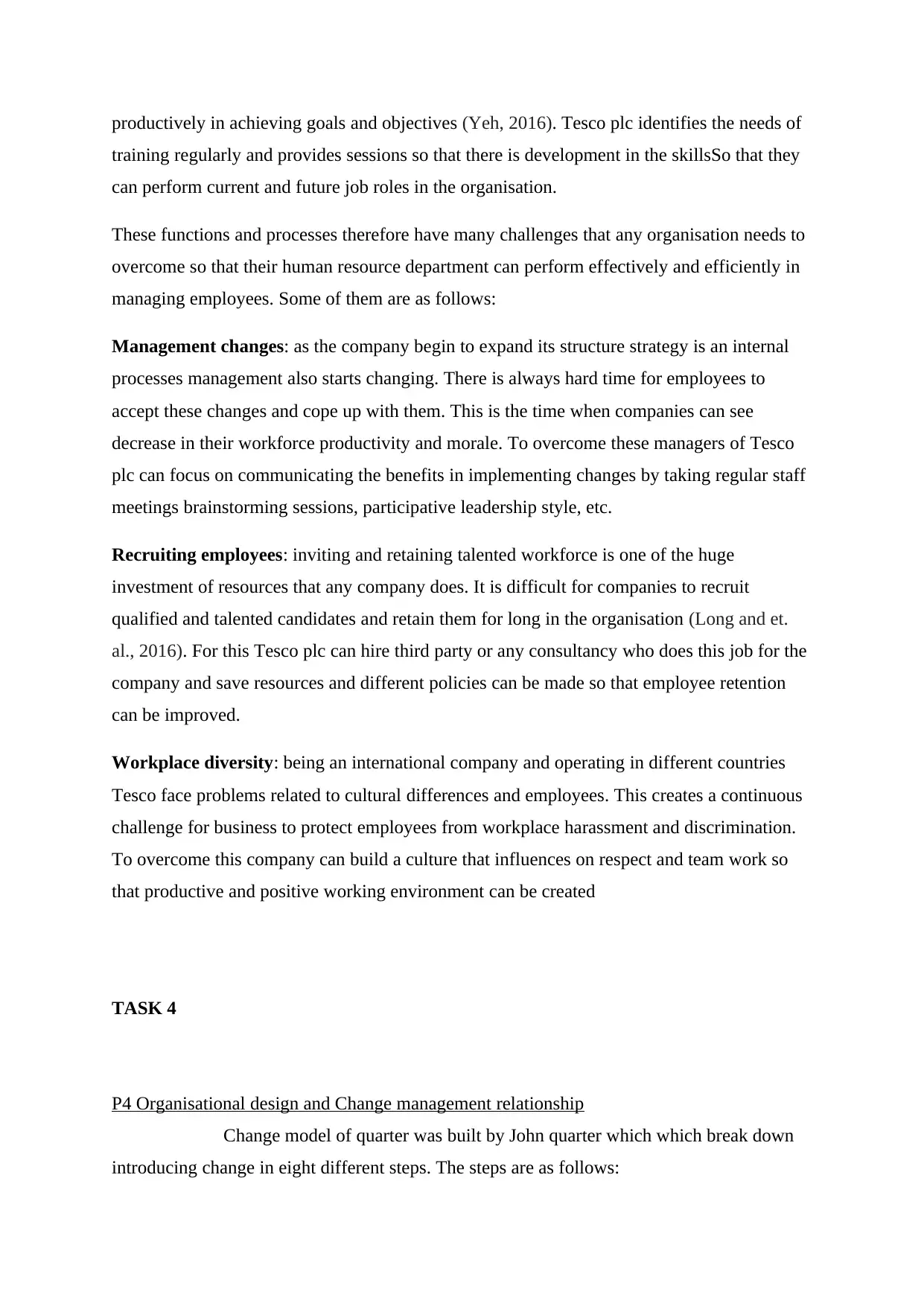
productively in achieving goals and objectives (Yeh, 2016). Tesco plc identifies the needs of
training regularly and provides sessions so that there is development in the skillsSo that they
can perform current and future job roles in the organisation.
These functions and processes therefore have many challenges that any organisation needs to
overcome so that their human resource department can perform effectively and efficiently in
managing employees. Some of them are as follows:
Management changes: as the company begin to expand its structure strategy is an internal
processes management also starts changing. There is always hard time for employees to
accept these changes and cope up with them. This is the time when companies can see
decrease in their workforce productivity and morale. To overcome these managers of Tesco
plc can focus on communicating the benefits in implementing changes by taking regular staff
meetings brainstorming sessions, participative leadership style, etc.
Recruiting employees: inviting and retaining talented workforce is one of the huge
investment of resources that any company does. It is difficult for companies to recruit
qualified and talented candidates and retain them for long in the organisation (Long and et.
al., 2016). For this Tesco plc can hire third party or any consultancy who does this job for the
company and save resources and different policies can be made so that employee retention
can be improved.
Workplace diversity: being an international company and operating in different countries
Tesco face problems related to cultural differences and employees. This creates a continuous
challenge for business to protect employees from workplace harassment and discrimination.
To overcome this company can build a culture that influences on respect and team work so
that productive and positive working environment can be created
TASK 4
P4 Organisational design and Change management relationship
Change model of quarter was built by John quarter which which break down
introducing change in eight different steps. The steps are as follows:
training regularly and provides sessions so that there is development in the skillsSo that they
can perform current and future job roles in the organisation.
These functions and processes therefore have many challenges that any organisation needs to
overcome so that their human resource department can perform effectively and efficiently in
managing employees. Some of them are as follows:
Management changes: as the company begin to expand its structure strategy is an internal
processes management also starts changing. There is always hard time for employees to
accept these changes and cope up with them. This is the time when companies can see
decrease in their workforce productivity and morale. To overcome these managers of Tesco
plc can focus on communicating the benefits in implementing changes by taking regular staff
meetings brainstorming sessions, participative leadership style, etc.
Recruiting employees: inviting and retaining talented workforce is one of the huge
investment of resources that any company does. It is difficult for companies to recruit
qualified and talented candidates and retain them for long in the organisation (Long and et.
al., 2016). For this Tesco plc can hire third party or any consultancy who does this job for the
company and save resources and different policies can be made so that employee retention
can be improved.
Workplace diversity: being an international company and operating in different countries
Tesco face problems related to cultural differences and employees. This creates a continuous
challenge for business to protect employees from workplace harassment and discrimination.
To overcome this company can build a culture that influences on respect and team work so
that productive and positive working environment can be created
TASK 4
P4 Organisational design and Change management relationship
Change model of quarter was built by John quarter which which break down
introducing change in eight different steps. The steps are as follows:
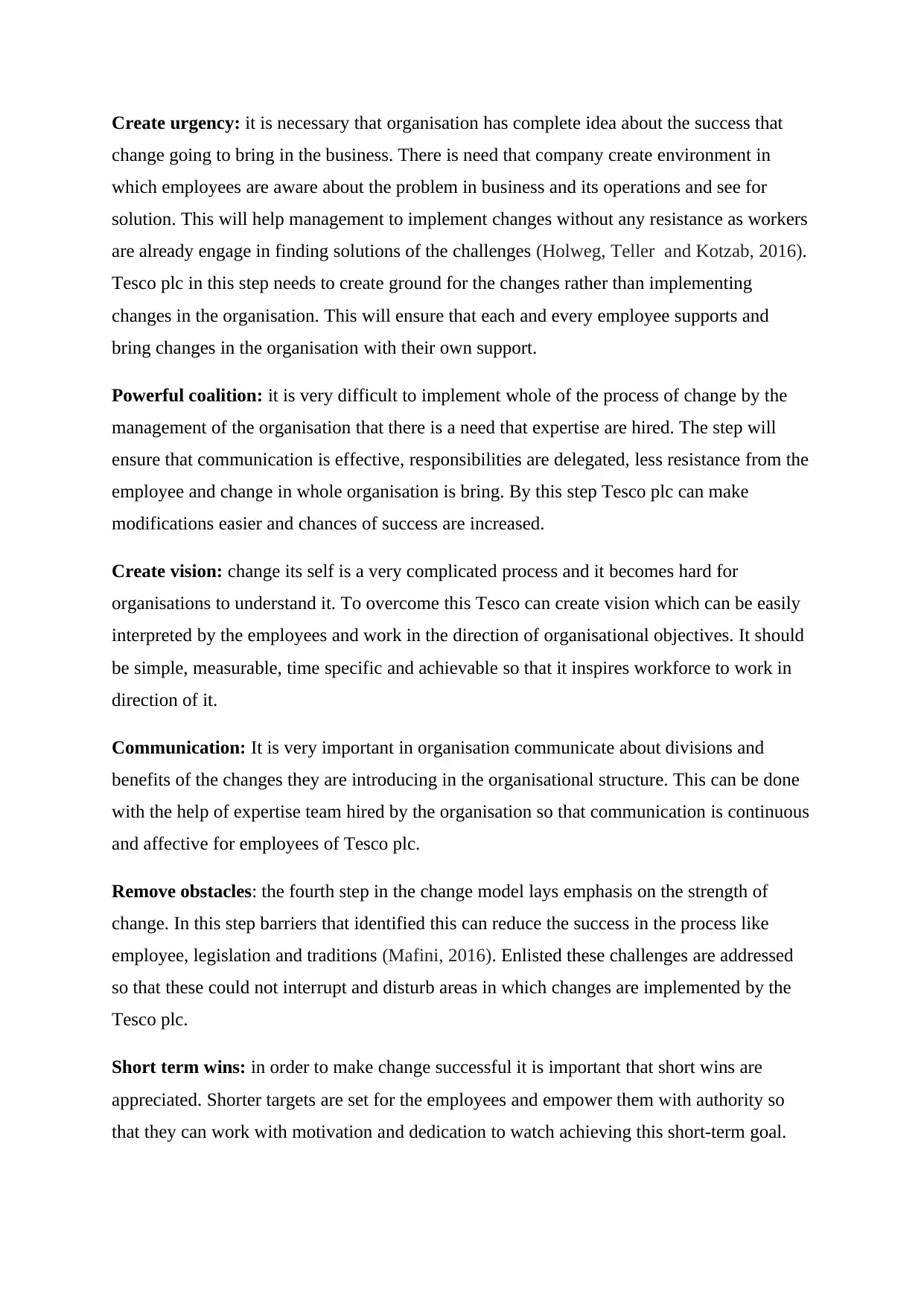
Create urgency: it is necessary that organisation has complete idea about the success that
change going to bring in the business. There is need that company create environment in
which employees are aware about the problem in business and its operations and see for
solution. This will help management to implement changes without any resistance as workers
are already engage in finding solutions of the challenges (Holweg, Teller and Kotzab, 2016).
Tesco plc in this step needs to create ground for the changes rather than implementing
changes in the organisation. This will ensure that each and every employee supports and
bring changes in the organisation with their own support.
Powerful coalition: it is very difficult to implement whole of the process of change by the
management of the organisation that there is a need that expertise are hired. The step will
ensure that communication is effective, responsibilities are delegated, less resistance from the
employee and change in whole organisation is bring. By this step Tesco plc can make
modifications easier and chances of success are increased.
Create vision: change its self is a very complicated process and it becomes hard for
organisations to understand it. To overcome this Tesco can create vision which can be easily
interpreted by the employees and work in the direction of organisational objectives. It should
be simple, measurable, time specific and achievable so that it inspires workforce to work in
direction of it.
Communication: It is very important in organisation communicate about divisions and
benefits of the changes they are introducing in the organisational structure. This can be done
with the help of expertise team hired by the organisation so that communication is continuous
and affective for employees of Tesco plc.
Remove obstacles: the fourth step in the change model lays emphasis on the strength of
change. In this step barriers that identified this can reduce the success in the process like
employee, legislation and traditions (Mafini, 2016). Enlisted these challenges are addressed
so that these could not interrupt and disturb areas in which changes are implemented by the
Tesco plc.
Short term wins: in order to make change successful it is important that short wins are
appreciated. Shorter targets are set for the employees and empower them with authority so
that they can work with motivation and dedication to watch achieving this short-term goal.
change going to bring in the business. There is need that company create environment in
which employees are aware about the problem in business and its operations and see for
solution. This will help management to implement changes without any resistance as workers
are already engage in finding solutions of the challenges (Holweg, Teller and Kotzab, 2016).
Tesco plc in this step needs to create ground for the changes rather than implementing
changes in the organisation. This will ensure that each and every employee supports and
bring changes in the organisation with their own support.
Powerful coalition: it is very difficult to implement whole of the process of change by the
management of the organisation that there is a need that expertise are hired. The step will
ensure that communication is effective, responsibilities are delegated, less resistance from the
employee and change in whole organisation is bring. By this step Tesco plc can make
modifications easier and chances of success are increased.
Create vision: change its self is a very complicated process and it becomes hard for
organisations to understand it. To overcome this Tesco can create vision which can be easily
interpreted by the employees and work in the direction of organisational objectives. It should
be simple, measurable, time specific and achievable so that it inspires workforce to work in
direction of it.
Communication: It is very important in organisation communicate about divisions and
benefits of the changes they are introducing in the organisational structure. This can be done
with the help of expertise team hired by the organisation so that communication is continuous
and affective for employees of Tesco plc.
Remove obstacles: the fourth step in the change model lays emphasis on the strength of
change. In this step barriers that identified this can reduce the success in the process like
employee, legislation and traditions (Mafini, 2016). Enlisted these challenges are addressed
so that these could not interrupt and disturb areas in which changes are implemented by the
Tesco plc.
Short term wins: in order to make change successful it is important that short wins are
appreciated. Shorter targets are set for the employees and empower them with authority so
that they can work with motivation and dedication to watch achieving this short-term goal.
⊘ This is a preview!⊘
Do you want full access?
Subscribe today to unlock all pages.

Trusted by 1+ million students worldwide

Build change: there are many instances where change process has failed because they are not
properly. Does this theory lay emphasis to sustain the change for longer term even after it has
been implemented in the organisation. To assure this Tesco plc can set goals and analyse
strategies that can be implemented for continuous improvement of the changes.
Changes in corporate culture: simply by just implementing changes in the organisation will
not bring cultural change in the whole of the business. Does there is a need that stakeholders,
employees, outside parties are encouraged to adopt these changes as well.
Even after the change model there are different type of barriers that can affect this process
and leads to Celia in implementing changes in the organisation. Some of them are as follows:
Employee Resistance: One of the major barriers that any organisation faces while
bringing changes in the structure of design is resistance from their workforce. This is one of
the most inevitable barrier that arises due to fear of unknown, unemployment, less efficiency
and uncertainties that will come with the changes (Pradhan, Panda and Jena, 2017). This
makes workers to oppose the management while bringing changes and create obstacles in
implementing the process.This can be overcome by increasing participation of subordinates,
brainstorming sessions to come up with the idea to implement the changes and motivate
employees to develop new skills. All these measures will minimise the resistance from the
employees as they will be now understanding about the benefits they are getting from the
changes that management is making in the Tesco plc
Poor Communication: management need to understand that changes on the ground
level are made for the employees. Does it is very important that open and effective
communication is maintained so that they are informed about each and every policies or
procedures that are taking place in the change process. In case if there is less or no
communication about the modification this will act as a barrier in the whole procedure. Does
there is a need that Tesco communicate not even in the implementing face but also at the
stage of planning these changes. This will be to a communication and veg ideas, solution,
suggestions will be invited and involved in the decision-making for exit you think change
process in the organisation.
Lack of Strategies: from the very moment in planning or implementing
organisational changes it is important that organisation have clear objectives and goals. It is
properly. Does this theory lay emphasis to sustain the change for longer term even after it has
been implemented in the organisation. To assure this Tesco plc can set goals and analyse
strategies that can be implemented for continuous improvement of the changes.
Changes in corporate culture: simply by just implementing changes in the organisation will
not bring cultural change in the whole of the business. Does there is a need that stakeholders,
employees, outside parties are encouraged to adopt these changes as well.
Even after the change model there are different type of barriers that can affect this process
and leads to Celia in implementing changes in the organisation. Some of them are as follows:
Employee Resistance: One of the major barriers that any organisation faces while
bringing changes in the structure of design is resistance from their workforce. This is one of
the most inevitable barrier that arises due to fear of unknown, unemployment, less efficiency
and uncertainties that will come with the changes (Pradhan, Panda and Jena, 2017). This
makes workers to oppose the management while bringing changes and create obstacles in
implementing the process.This can be overcome by increasing participation of subordinates,
brainstorming sessions to come up with the idea to implement the changes and motivate
employees to develop new skills. All these measures will minimise the resistance from the
employees as they will be now understanding about the benefits they are getting from the
changes that management is making in the Tesco plc
Poor Communication: management need to understand that changes on the ground
level are made for the employees. Does it is very important that open and effective
communication is maintained so that they are informed about each and every policies or
procedures that are taking place in the change process. In case if there is less or no
communication about the modification this will act as a barrier in the whole procedure. Does
there is a need that Tesco communicate not even in the implementing face but also at the
stage of planning these changes. This will be to a communication and veg ideas, solution,
suggestions will be invited and involved in the decision-making for exit you think change
process in the organisation.
Lack of Strategies: from the very moment in planning or implementing
organisational changes it is important that organisation have clear objectives and goals. It is
Paraphrase This Document
Need a fresh take? Get an instant paraphrase of this document with our AI Paraphraser
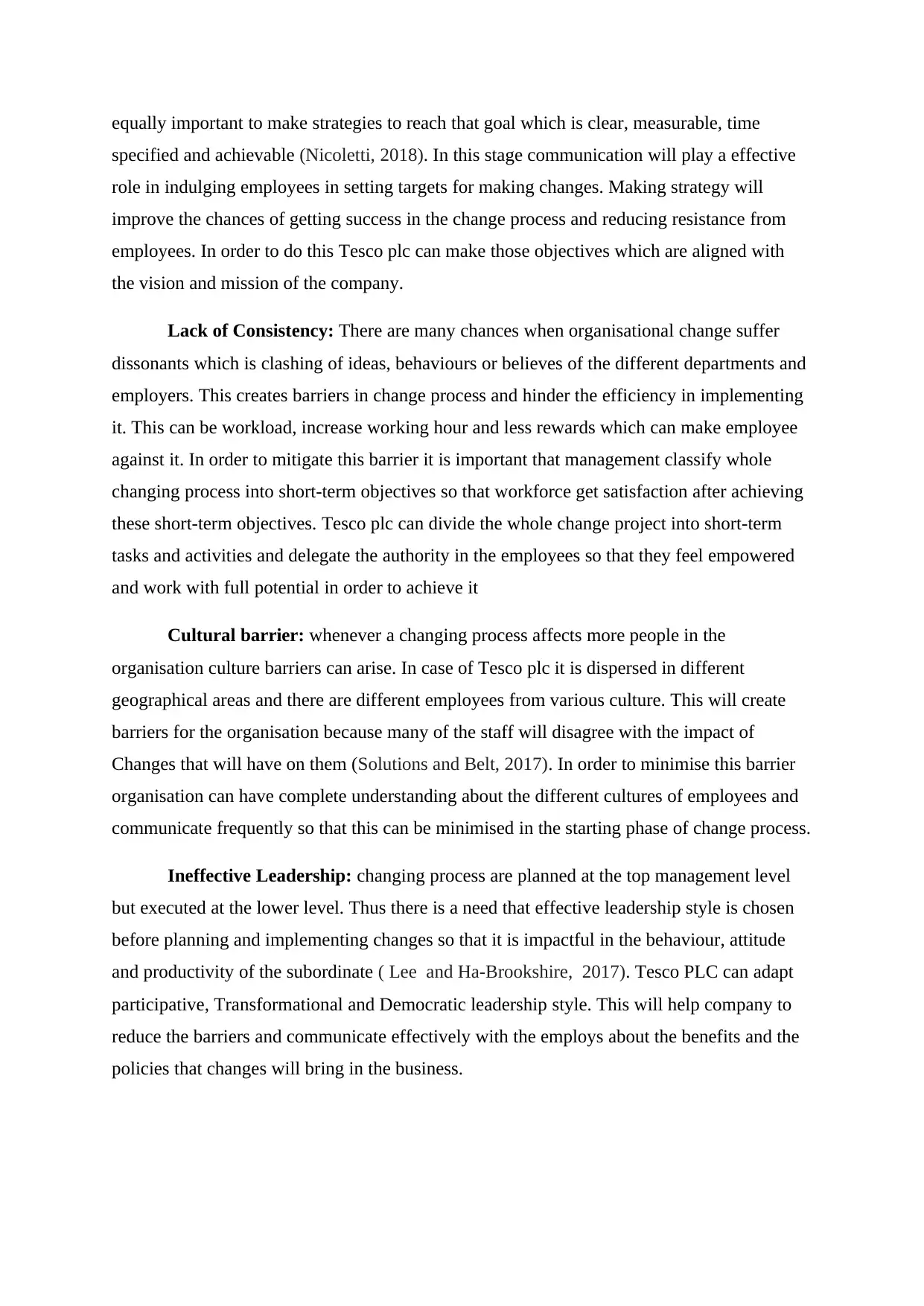
equally important to make strategies to reach that goal which is clear, measurable, time
specified and achievable (Nicoletti, 2018). In this stage communication will play a effective
role in indulging employees in setting targets for making changes. Making strategy will
improve the chances of getting success in the change process and reducing resistance from
employees. In order to do this Tesco plc can make those objectives which are aligned with
the vision and mission of the company.
Lack of Consistency: There are many chances when organisational change suffer
dissonants which is clashing of ideas, behaviours or believes of the different departments and
employers. This creates barriers in change process and hinder the efficiency in implementing
it. This can be workload, increase working hour and less rewards which can make employee
against it. In order to mitigate this barrier it is important that management classify whole
changing process into short-term objectives so that workforce get satisfaction after achieving
these short-term objectives. Tesco plc can divide the whole change project into short-term
tasks and activities and delegate the authority in the employees so that they feel empowered
and work with full potential in order to achieve it
Cultural barrier: whenever a changing process affects more people in the
organisation culture barriers can arise. In case of Tesco plc it is dispersed in different
geographical areas and there are different employees from various culture. This will create
barriers for the organisation because many of the staff will disagree with the impact of
Changes that will have on them (Solutions and Belt, 2017). In order to minimise this barrier
organisation can have complete understanding about the different cultures of employees and
communicate frequently so that this can be minimised in the starting phase of change process.
Ineffective Leadership: changing process are planned at the top management level
but executed at the lower level. Thus there is a need that effective leadership style is chosen
before planning and implementing changes so that it is impactful in the behaviour, attitude
and productivity of the subordinate ( Lee and Ha-Brookshire, 2017). Tesco PLC can adapt
participative, Transformational and Democratic leadership style. This will help company to
reduce the barriers and communicate effectively with the employs about the benefits and the
policies that changes will bring in the business.
specified and achievable (Nicoletti, 2018). In this stage communication will play a effective
role in indulging employees in setting targets for making changes. Making strategy will
improve the chances of getting success in the change process and reducing resistance from
employees. In order to do this Tesco plc can make those objectives which are aligned with
the vision and mission of the company.
Lack of Consistency: There are many chances when organisational change suffer
dissonants which is clashing of ideas, behaviours or believes of the different departments and
employers. This creates barriers in change process and hinder the efficiency in implementing
it. This can be workload, increase working hour and less rewards which can make employee
against it. In order to mitigate this barrier it is important that management classify whole
changing process into short-term objectives so that workforce get satisfaction after achieving
these short-term objectives. Tesco plc can divide the whole change project into short-term
tasks and activities and delegate the authority in the employees so that they feel empowered
and work with full potential in order to achieve it
Cultural barrier: whenever a changing process affects more people in the
organisation culture barriers can arise. In case of Tesco plc it is dispersed in different
geographical areas and there are different employees from various culture. This will create
barriers for the organisation because many of the staff will disagree with the impact of
Changes that will have on them (Solutions and Belt, 2017). In order to minimise this barrier
organisation can have complete understanding about the different cultures of employees and
communicate frequently so that this can be minimised in the starting phase of change process.
Ineffective Leadership: changing process are planned at the top management level
but executed at the lower level. Thus there is a need that effective leadership style is chosen
before planning and implementing changes so that it is impactful in the behaviour, attitude
and productivity of the subordinate ( Lee and Ha-Brookshire, 2017). Tesco PLC can adapt
participative, Transformational and Democratic leadership style. This will help company to
reduce the barriers and communicate effectively with the employs about the benefits and the
policies that changes will bring in the business.
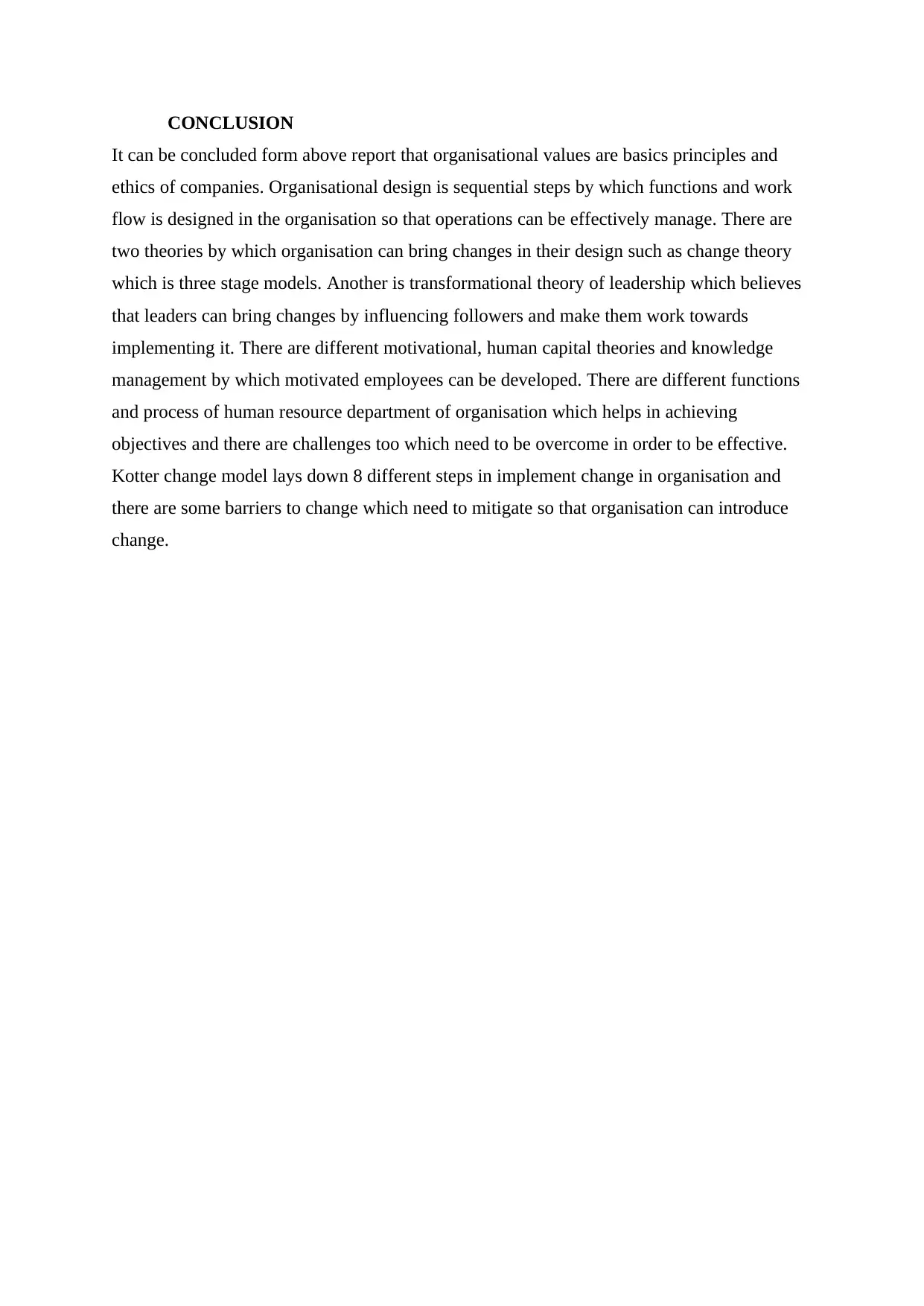
CONCLUSION
It can be concluded form above report that organisational values are basics principles and
ethics of companies. Organisational design is sequential steps by which functions and work
flow is designed in the organisation so that operations can be effectively manage. There are
two theories by which organisation can bring changes in their design such as change theory
which is three stage models. Another is transformational theory of leadership which believes
that leaders can bring changes by influencing followers and make them work towards
implementing it. There are different motivational, human capital theories and knowledge
management by which motivated employees can be developed. There are different functions
and process of human resource department of organisation which helps in achieving
objectives and there are challenges too which need to be overcome in order to be effective.
Kotter change model lays down 8 different steps in implement change in organisation and
there are some barriers to change which need to mitigate so that organisation can introduce
change.
It can be concluded form above report that organisational values are basics principles and
ethics of companies. Organisational design is sequential steps by which functions and work
flow is designed in the organisation so that operations can be effectively manage. There are
two theories by which organisation can bring changes in their design such as change theory
which is three stage models. Another is transformational theory of leadership which believes
that leaders can bring changes by influencing followers and make them work towards
implementing it. There are different motivational, human capital theories and knowledge
management by which motivated employees can be developed. There are different functions
and process of human resource department of organisation which helps in achieving
objectives and there are challenges too which need to be overcome in order to be effective.
Kotter change model lays down 8 different steps in implement change in organisation and
there are some barriers to change which need to mitigate so that organisation can introduce
change.
⊘ This is a preview!⊘
Do you want full access?
Subscribe today to unlock all pages.

Trusted by 1+ million students worldwide
1 out of 14
Related Documents
Your All-in-One AI-Powered Toolkit for Academic Success.
+13062052269
info@desklib.com
Available 24*7 on WhatsApp / Email
![[object Object]](/_next/static/media/star-bottom.7253800d.svg)
Unlock your academic potential
Copyright © 2020–2025 A2Z Services. All Rights Reserved. Developed and managed by ZUCOL.





